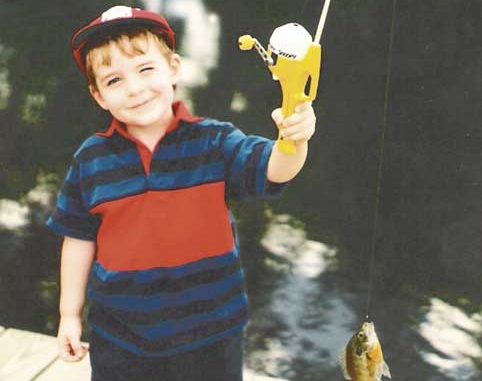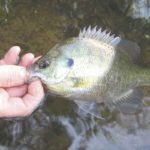
It’s high time for the best bream fishing South Carolina has to offer.
The full moon in June.Has a nice ring to it, doesn’t it?
That simple refrain certainly has a resounding significance for many “bream” fishermen across the Palmetto State, including Jim Wyatt of Greenville.
Wyatt, 75 years young, makes frequent pilgrimages to a private and productive Greenwood County pond whenever his summertime schedule permits, but his eyes really twinkle if he can slip away on the cusp of the full moon.
“That’s when they get on the beds in shallow water and hang out together,” Wyatt said. “They protect those beds, and they’ll knock out whatever gets in there.”
In Wyatt’s case, that’s usually a plump cricket, and on one June day, it didn’t take long for Wyatt to realize his desired result.
He lofted a looping cast with a small spinning outfit, a cricket still kicking on the business end of his line, three feet below a cork.
“They love those crickets,” Wyatt said. “If you’re in the right spot, the next thing you know, your cork is gone.”
Sure enough, before the ripples from the “kerplunk” of his bream rig had time to dissipate, Wyatt’s cork danced about the surface for a couple of seconds, then disappeared into the depths.
“That feels like a good one,” Wyatt said.
It was. Wyatt quickly and efficiently reeled in a chunky bluegill that would make any bream buster worth his salt yearn for more.
It was a “full-grown bream,” as Wyatt says — one that requires pinning the fish’s flattened body against your chest to facilitate hook removal.
A minute later, he repeated the process with another bream that appeared to weigh a pound or better. Wyatt was a longtime athletic official, and although he’s now retired, it comes as no surprise that he is pretty good at keeping score.
“That two for me, zero for you,” he said, quickly reloading with another cricket.
Scorekeeping notwithstanding, such scenarios are commonplace across South Carolina during the summer months, when bream render themselves most catchable.
Throughout much of the state, the term “bream” sometimes is used as an all-inclusive description for a variety of panfish including bluegills, shellcrackers, redbreast and pumpkinseed. But for most anglers, bream means bluegills — those widespread denizens of the shallows that fan their crater-like beds in waters small and large, from the coastal plain to the mountains.
Although plenty of bluegills migrate into shallow-water bedding areas during the full moon in May, it’s the full moon in June that truly ushers in the onset of bream season.
“Shellcrackers spawn early, typically around the first two full moons of the spring, but bream will spawn throughout the summer — even into September,” said Scott Lamprecht, a fisheries biologist with the S.C. Department of Natural Resources (SCDNR). “And bream are colonial spawners; they like to spawn together.”
Gene Hayes, a fellow DNR fisheries biologist, enjoys catching bream himself, affording him plenty of opportunities to form first-hand opinions on what lies in store each summer.
“We usually try to hit them around Memorial Day and on into June,” Hayes said. “Those are the times that come to mind when I think of the first big bream spawn of the year. But bluegill will spawn about every 28 to 30 days once the water temperature gets above 70 degrees, so it can really be an extended fishing season.”
But what about the full moon fever?
“I’ve heard that all my life, too,” Hayes said. “It’s a standard thing you hear when people talk about fishing for bream. I don’t know that there’s scientific basis for making that statement, but lunar cycles do play a part in the behavior of other animals, so there may be something to it.”
Still another fisheries biologist, Dan Rankin of the SCDNR’s Upstate office near Clemson, also admitted to having little scientific proof of the full-moon effect, but he isn’t about to question the bream-catching success he’s experienced on and around the full moon.
“From my fishing experience, it seems to be a pretty good rule of thumb,” Rankin said. “When it comes to bream fishing, the full moon seems to be a trigger.”
Richard Hall of Lake World, a tackle shop on the Lexington side of the Lake Murray Dam, agrees somewhat with the “full-moon theory,” but believes that the concept is enhanced by longstanding tradition.
“Everybody’s heard the full-moon thing their entire lives, so everybody goes fishing for bream then,” Hall said. “We do see a lot of bream caught around the full moon, but a lot of that probably has to do with the fact that there are more people out there fishing for them at those times.”
Although some fisheries experts and anglers contend that the full-moon bream bite is a contentious argument, there are plenty of fishermen who already have June 18, July 18 and Aug. 16 circled on their fishing calendars. Include Jody Pack, a 47-year veteran guide out of Pack’s Landing on Lake Marion, among them.
“I can tell by the crowd in our parking lot when the full moon is,” Pack said. “If somebody calls me to book a bream-fishing trip and they give me a good time frame, I’ll say, ‘Let’s go around the full moon.’
“You don’t have to hit the full moon right on the nose, but I try to keep it within four days — two days before, two days after. Some fish will be moving in and some will be moving off during that time, so that makes for good fishing for a while. If someone is taking the time to catch big numbers of fish, I say yes, absolutely, it’s important to go on the full moon. During the full moon, they’re concentrated on the beds, so catching them is a lot easier.”
And easy is the name of the game when it comes to bluegills. Their abundance — in the largest of reservoirs to the smallest of ponds — makes bluegills an angling option for all fishermen, regardless of age. Many is the veteran angler who cut his or her fishing teeth by reeling in bluegills from the local pond.
Salem’s Jim Davenport, who was fishing in Lake Jocassee waters long before they were impounded, has been bullish on bluegills for years, particularly when his grandchildren are involved.
“I enjoy it, and when they’re on the beds, that’s when you take the grandkids,” Davenport said. “That’s the time to get the kids started, get them out there on the lake. Most kids at that age aren’t going to have the patience to bass fish with a plastic worm, but when you’re bream fishing and they’re biting, that’s a different story.”
Before female bluegills move into shallow water to spawn, generally on sandy bottom areas, the male bluegills — or “bucks” — use their tails and fins to create nests. These familiar sights, which resemble small craters, will soon host the females, which may deposit up to 60,000 eggs.
“I’ll start looking for the bream on the first full moon in May, but it really heats up in June,” Davenport said. “I know where to go, where the shallow water and sand bars are. I’ll start looking for those round white circles.”
Bream will staunchly defend their nests, which plays directly into the hands of anglers. Crickets are the overwhelming bait of choice of most fishermen, but other offerings can fill the cooler as well, including redworms, meal worms, grubs and even small minnows. And when the bite is fast and furious, just about anything will do the trick.
“Once you get them really cranked up, they’ll take anything — a piece of squid, any little piece of meat,” says David Hilton, a Santee Cooper fishing guide.
“I’ll put on a little split-shot, about BB size, and let it sink right down into the bed,” Davenport said. “Most of the time, they’ll hit it before it hits the bottom of the bed, and you’ll see that line take off.”
Davenport has successfully “patterned” the bluegills at Jocassee, a clear, cool-water reservoir that affords bream beds to be located fairly easily, regardless of depth. He’ll follow them out to progressively deeper water as the summer progresses, catching them successfully at every stop.
“At Jocassee, they’ll be on the beds in May for about 10 days, then back off,” Davenport said. “Then they’re back on again four weeks later in June. A lot of times as the summer goes on, they’ll start backing off more and more. In June, I’m catching them deeper than I did in May. And in July, I’m catching them deeper than I did in June. They’ve got to stay with a certain water temperature.”
This same type of movement holds true in other lakes. At reservoirs such as Hartwell and Clarks Hill, bluegill will congregate in shallows two to five feet deep in June, with overhanging button bushes and other vegetation along the shoreline providing likely areas of mass convergence. At Santee Cooper, cypress trees, roots and stumps supply a world of cover. But in all cases, the bluegills will adjust their primary bedding depth month-by-month.
“They just keeping backing out a little deeper,” Hilton said. “Instead of being right up on the hill like they are in May, they may be five or six feet deep in June and out in seven or eight feet of water by July. But even though they go deeper, they’re still bunched up pretty good.”
Bluegills are custom-made for a variety of tackle options. Pack, who often targets shoreline areas rife with mayfly hatches, prefers an 11-foot cane pole for its simplicity and pinpoint presentation. Hilton uses an ultralight rod-and-reel combo. Davenport prefers a flyrod, with which he offers popping bugs. Mini jigs, Beetle Spins and a variety of dry and wet flies can be deadly at times, too.
Longtime Santee Cooper guide L.C. Wolfe is partial to tiny jigs.
“If I had to pick one color, it’d be something with chartreuse,” Wolfe said. “And a color with a little glitter sometimes works great.”
The key is to go light.
“You want ultralight line — 4- or 6-pound test,” Hall said. “It’s all about fun, anyway, so I go as light as I can possibly stand it.”
Light lines and eager, feisty flat-sided bluegills can create quite the angling experience. Bluegills are scrappy fighters, as fledgling anglers of all ages will quickly discover as their line cuts the water with a back-and-forth motion and a steady pull.
“The bream’s a tough fish,” Wolfe said. “If they consistently got up into the 5-pound range, we’d really have our hands full.”
J.P. Hegler undoubtedly had his hands full when he pulled a 3-pound, 4-ounce bluegill from a Lancaster County pond in 1973, establishing one of the state’s longest-standing freshwater records. But most bluegills are considerably smaller, typically running six to eight inches in length and weighing a quarter- to a half-pound.
But this much is certain: bluegills are fun and rewarding to catch, regardless of size. And particularly when they’re destined for the table. Many anglers consider bluegills to be beyond compare when it comes time for a fish fry.
“That’s one of best meats you can have,” Davenport said. “Compared to other fish, it’s kind of sweet and pearly white. If I get a good hand-sized bream, I fillet ’em. When they’re not so big, I call ’em popcorn bream. But when you season them up and drop ’em into some hot oil, you’ve really got something good.”
And the getting starts getting good in June, with a summer full of catching to follow.
By the admission of many anglers, the full moon is prime time, but any time can be a good time when chasing summer bluegills.
“It doesn’t have to be exactly on the full moon for me to go,” Davenport said. “I’m not one of those people who goes strictly by that. I had a guy ask me once if I fished by the signs, and I said, ‘Yeah. Every time the sun rises in the east, I go.’”








Be the first to comment